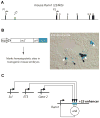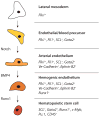Hematopoietic stem cell emergence in the conceptus and the role of Runx1
- PMID: 20711992
- PMCID: PMC4512753
- DOI: 10.1387/ijdb.103106gs
Hematopoietic stem cell emergence in the conceptus and the role of Runx1
Abstract
Hematopoietic stem cells (HSCs) are functionally defined as cells that upon transplantation into irradiated or otherwise immunocompromised adult organisms provide long-term reconstitution of the entire hematopoietic system. They emerge in the vertebrate conceptus around midgestation. Genetic studies have identified a number of transcription factors and signaling molecules that act at the onset of hematopoiesis, and have begun to delineate the molecular mechanisms underlying the formation of HSCs. One molecule that has been a particularly useful marker of this developmental event in multiple species is Runx1 (also known as AML1, Pebp2alpha). Runx1 is a sequence-specific DNA-binding protein, that along with its homologues Runx2 and Runx3 and their shared non-DNA binding subunit CBFbeta, constitute a small family of transcription factors called core-binding factors (CBFs). Runx1 is famous for its role in HSC emergence, and notorious for its involvement in leukemia, as chromosomal rearrangements and inactivating mutations in the human RUNX1 gene are some of the most common events in de novo and therapy-related acute myelogenous leukemia, myelodysplastic syndrome and acute lymphocytic leukemia. Here we will review the role of Runx1 in HSC emergence in the mouse conceptus and describe some of the genetic pathways that operate upstream and downstream of this gene. Where relevant, we will include data obtained from other species and embryonic stem (ES) cell differentiation cultures.
Figures



References
-
- ALVAREZ-SILVA M, BELO-DIABANGOUAYA P, SALAUN J, DIETERLEN-LIEVRE F. Mouse placenta is a major hematopoietic organ. Development. 2003;130:5437–5444. - PubMed
-
- ARAI F, HIRAO A, OHMURA M, SATO H, MATSUOKA S, TAKUBO K, ITO K, KOH GY, SUDA T. Tie2/angiopoietin-1 signaling regulates hematopoietic stem cell quiescence in the bone marrow niche. Cell. 2004;118:149–161. - PubMed
-
- BEE T, ASHLEY EL, BICKLEY SR, JARRATT A, LI PS, SLOANE-STANLEY J, GOTTGENS B, DE BRUIJN MF. The mouse Runx1 +23 hematopoietic stem cell enhancer confers hematopoietic specificity to both Runx1 promoters. Blood. 2009a;113:5121–5124. - PubMed
Publication types
MeSH terms
Substances
Grants and funding
LinkOut - more resources
Full Text Sources
Other Literature Sources
Medical

